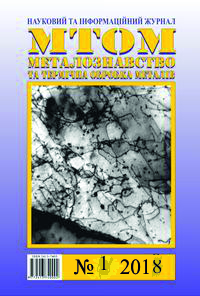Direction of practical use in the power engineering of the phenomenon of electrochemical phase formation in metals and alloys via a supercooled liquid state stage
DOI:
https://doi.org/10.30838/J.PMHTM.2413.240418.67.107Keywords:
electrochemical phase formation, surface morphology, electrical property, electrodeposited foil, chemical current sourceAbstract
Purpose. The direction of practical use in power engineering of the discovered phenomenon of electrochemical phase formation in metals and alloys via a supercooled liquid state stage is required to determine. Methodology. The methods of scanning electron microscopy and impedance spectroscopy were used. Findings. The surface morphology and electrical properties of metallic (copper and nickel) foils obtained by the usual method of electrodeposition and the method of stimulated nucleation during solidification of a supercooled liquid phase of the metal being electrodeposited are studied. The effect of reducing the transient electrical resistance at the current lead / electrode interface has been established when using copper or nickel foil with a branched surface morphology as a current lead. The direction of practical use of the established phenomenon in the production of chemical sources of current is determined. Originality. The relationship between the surface morphology and the electrical properties of the metallic foil is revealed. Practical value. The obtained results open the prospect of manufacturing chemical current sources having increased power and stability.
References
Girin O. B. Phenomenon of precipitation of metal being electrodeposited, occurring via formation of an undercooled liquid metal phase and its subsequent solidification. Part 1. Experimental detection and theoretical grounding / O. B. Girin // Materials Development and Processing / Eds. J. V. Wood, L. Schultz, D. M. Herlach. – Weinheim : WILEY-VCH Verlag Gmbh, 2000. – Vol. 8. – Pр. 183–188. – Режим доступу : http://onlinelibrary.wiley.com/doi/10.1002/3527607277.ch30/summary
Girin O. B. Phenomenon of precipitation of metal being electrodeposited, occurring via formation of an undercooled liquid metal phase and its subsequent solidification. Part 2. Experimental verification / O. B. Girin // Materials Development and Processing / Eds. J. V. Wood, L. Schultz, D. M. Herlach. – Weinheim : WILEY-VCH Verlag Gmbh, 2000. – Vol. 8. – Pр. 189–194. – Режим доступу : http://onlinelibrary.wiley.com/doi/10.1002/3527607277.ch31/summary
Girin O. B. Further evidence of phase formation through a liquid state stage in metals being electrodeposited: Part 1 / O. B. Girin // Surface Engineering and Applied Electrochemistry. – 2017. – Vol. 53, № 2. – Pр. 137–143. – Режим доступу : https://link.springer.com/article/10.3103/S1068375517020041
Girin O. B. Further evidence of phase formation through a liquid state stage in metals being electrodeposited: Part 2 / O. B. Girin // Surface Engineering and Applied Electrochemistry. – 2017. – Vol. 53, № 3. – Pр. 233–239. – Режим доступу : https://link.springer.com/article/10.3103/S1068375517030048
Girin O. B. Further evidence of phase formation through a liquid state stage in metals being electrodeposited: Part 3 / O. B. Girin // Surface Engineering and Applied Electrochemistry. – 2017. – Vol. 53, № 4. – Pр. 339–344. – Режим доступу : https://link.springer.com/article/10.3103/S1068375517040056
Girin O. B. Understanding the corrosion resistance and reflectivity of electrodeposited zinc coatings obtained on pipes via a combined characteristic of their texture and surface morphology / O. B. Girin, S. I. Zhdanov // Materials Science & Technology Conference and Exhibition 2017 (MS&T'17): proceedings. – Red Hook (USA), 2017. – Vol. 1. – Pр. 1078–1082. – Режим доступу : https://www.matscitechproceedings.org/gp/gp_multiconferencesite_tms/mst17/Data/pdfs/284-115915.pdf
Коровин Н. В. Химические источники тока. Современное состояние / Н. В. Коровин // Электрохимическая энергетика. – 2003. – Т. 3, № 4. – С. 163-168. – Режим доступу : https://www.sgu.ru/sites/default/files/journal/izvestia/pdf/2013/12/27/20030401.pdf
Zhang S. S. Liquid electrolyte lithium/sulfur battery: fundamental chemistry, problems, and solutions / S. S. Zhang // Journal of Power Sources. – 2013. – Vol. 231, № 1. – P. 153–162. – Режим доступу : https://www.sciencedirect.com/science/article/pii/S0378775312019568
Soloveichik G. L. Flow batteries: Current status and trends / G. L. Soloveichik // Chemical Reviews. – 2015. – Vol. 115, № 20. – Pр. 11533–11558. – Режим доступу : https://pubs.acs.org/doi/abs/10.1021/cr500720t
Ahn Y. Altering anode thickness to improve power production in microbial fuel cells with different electrode distances / Y. Ahn, B. E. Logan // Energy Fuels. – 2013. – Vol. 27, № 1. – Pр. 271–276. – Режим доступу : https://pubs.acs.org/doi/abs/10.1021/ef3015553
Turney D. E. Rechargeable zinc alkaline anodes for long-cycle energy storage / D. E. Turney [et al.] // Chemistry of Materials. – 2017. – Vol. 29, № 11. – Pр. 4819–4832. – Режим доступу : https://pubs.acs.org/doi/abs/10.1021/acs.chemmater.7b00754
Скундин А. М. Современное состояние и перспективы развития литиевых аккумуляторов / А. М. Скундин, О. Н. Ефимов, О. В. Ярмоленко // Успехи химии. – 2002. – Т. 71, № 4. – С. 329–346. – Режим доступу : http://www.uspkhim.ru/php/paper_rus.phtml?journal_id=rc&paper_id=706
Downloads
Published
Issue
Section
License
Authors that are published in this journal agree to follow the conditions:
Authors reserve the right to the authorship of his work and cede the right to the journal of first publication of this work on conditions of the license under the Creative Commons Attribution License, which allows others to distribute it freely with the obligatory reference to the author of the original work and the first publication of the work in this journal.

